What We Know About Mule Deer Subspecies

Far-West Texas is home to the Desert Mule Deer, one of eleven subspecies of Odocoileus hemionus. Though larger than the Texas whitetail, Texas’ mule deer are smaller than their northern cousins.
For many reasons, far-West Texas’ mule deer numbers have been falling irregularly for years. The many perversities of so-called wildlife “management” are major contributing factors to the decline.
Humans do all manner of things to artificially increase numbers of favored species like mule deer and bighorn or manipulate physical attributes such as deer antler size. Most of these “management” practices have unintentionally harmed wildlife, rangelands and habitat.
NOTE: this article below is from MDF – the Official Magazine of the Mule Deer Foundation. It appeared in their March / April 2018 edition on Page 8, and was written by Jim Heffelfinger
Throughout the geographic range of mule deer and their black-tailed subspecies (Odocoileus he-mionus), we see a lot of variation in body size, coat color, antler shape, behavior,and other attributes.
For instance, mule deer in the southern latitudes are generally smaller in body size than those in the north and those inhabiting the deserts appear lighter in color than those in heavily forested regions. The physical variation in mule deer led early natural-ists to collect a mule deer from one location and another from someplace else and designate them as different species or subspecies because slight differences they described. Some of these differences may have been meaningful, but others simply reflected the variation one might see in a single population of deer.
Meet the Subspecies
From this sparse collection of deer, the geographic ranges of mule deer subspecies were drawn on a map. Without a better sampling of deer in different areas, it is not likely these original maps accurately reflected the distribution of different types of mule deer. It really doesn’t make sense in most cases that we have one kind of deer on one side of a line and a different type of deer on the other side. The purported differences between subspecies were often based on general observations of characteristics and not the kind of dataset we demand today. Some experts have tried to develop a way to definitively tell all the subspecies apart from one another and concluded it could not be done. However, two of the subspecies, Sitka and Columbian blacktails, differ genetically and physically from the rest of the mule deer. During one of the past ice ages, these two blacktail subspecies were isolated from mule deer and accumulated their differences.
Because of the lack of any clarifying information, the original list of subspecies has not been altered much through the years and so the same mule deer subpecies continue to be recognized today, regardless of whether they are valid or not. There have been 11 subspecies of black-tailed and mule deer named.
- Rocky Mountain Mule Deer (Odocoileus hemionus hemionus)
- Desert Mule Deer (Odocoileus hemionus crooki)
- Bura Mule Deer (Odocoileus hemionus eremicus)
- California Mule Deer (Odocoileus hemionus californicus)
- Southern Mule Deer (Odocoileus hemionus fuliginatus)
- Inyo Mule Deer (Odocoileus hemionus inyoensis)
- Peninsula Mule Deer (Odocoileus hemionus peninsulae)
- Tiburon Island Mule Deer (Odocoileus hemionus sheldoni)
- Cedros Island Mule Deer (Odocoileus hemionus cerrosensis)
- Columbian Black-Tailed Deer (Odocoileus hemionus columbianus)
- Sitka Black-Tailed Deer (Odocoileus hemionus sitkensis)
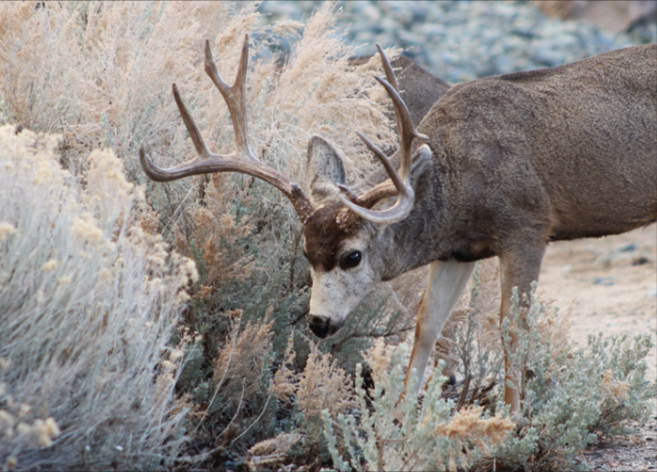
Mule deer have adapted to a wide range of conditions and some geographic differencesmay be important to recognize for conservation purposes.
What’s in a name?
These somewhat-arbitrary subspecies names have been repeated over and over in books, scientific papers, and magazines to the point that everyone assumes there is a solid scientific basis for these categories. One of the most frivolous subspecies assignments was the designation of a new eastern desert mule deer (different from western desert mule deer) based on the antler shape of a single buck skull lying uncatalogued in a museum. The naturalist simply gave the new subspecies a name and mapped a distribution for it.
In light of the uncertainty and confusion that current subspecies designations have produced, some have argued that it is time to discard subspecies names al- together. This solution, however, would be a little too drastic. It is meaningful to recognize some geographic differences for improved management, particularly if they provide a useful designation of a population that is physically or ecologically different. Rather than ignore local adaptations or disregard geographic differences, we should describe them accurately based on physical and genetic relationships that show true relatedness and differentiation. Subspecies solidly based in science provide useful units of conservation.
A New Look at Old Subspecies
Recent advances in genetic analysis techniques now allow researchers to evaluate genetic differences in ways that provide managers with meaningful ecological management units throughout the range of a species. Realizing the value of a genetic analysis of black-tailed and mule deer throughout North America, a coalition of conservation groups came together to fund one of the most ambitious projects of its kind. This evaluation of genetic differentiation can provide not only a basis for conservation efforts, but also help solidify the geographic range of different “types” of mule and black-tailed deer for accurate record-keeping purposes.
More than 2,700 tissue samples were collected from black-tailed and mule deer throughout their entire range in North America from A to Z (Alaska to Zacatecas). Most of these samples came from hunters who harvested deer and agreed to help with the study. Not all of these samples were needed to answer the questions at hand, so we selected a sub-sample of nearly 1,800 for inclusion in this analysis. Seventy sites across North America encompassing all historically recognized subspecies were selected for the analysis, including all the major ecological regions supporting black-tailed and mule deer.
There are a lot of different ways to analyze DNA to answer many different questions. Some people think of genetic analysis as if it were a black box that you put samples in one side and out pops a tree diagram from the other end showing who is more closely related to whom. It is not quite that simple; you have to select the right test to answer the question you want answered.
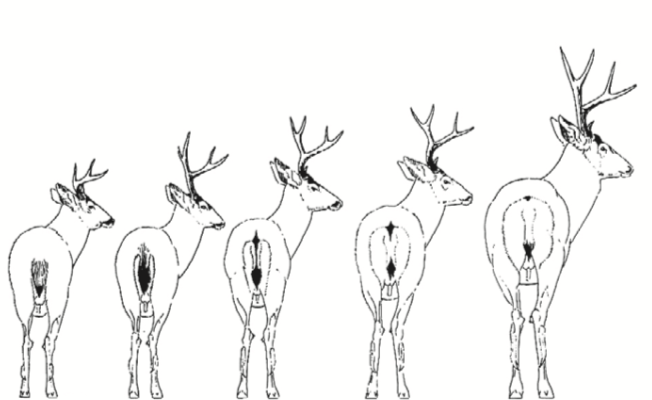
The mule deer/blacktail species ranges from a small island-hopping Sitka blacktail to a large Rocky Mountain mule deer.
To complete this research, I brought together Drs. Emily Latch and O. E.Rhodes, Jr., two wildlife geneticists recognized for their previous work in this area. Two kinds of DNA were analyzed: mitochondrial DNA (mtDNA) and nuclear DNA (nDNA). Samples were analyzed by sequencing portions of the mtDNA and by using microsatellites to look at variation in the nDNA. The number of samples we collected and analyzed exceeded nearly every other study of this type. Certainly no one has analyzed a large mammal throughout a continent at this scale and this presented some challenges in data management and interpretation, using scientifically-based groups as units of conservation.

Genetic analyses like microsatellites are allowing us to learn much more about how subspecies are related to one other.
The mule deer subspecies currently recognized have not helped us in delineating units of conservation and management. For instance, even the most recent textbooks contain the same stagnant, outdated information about mule deer subspecies because no one has reevaluated the same old list of subspecies names and designated ranges. If mule deer subspecies designations are to be of value in management, they must be based on genetic, ecological, and physical differences between populations of deer.
Identifying the different types of mule deer that exist may be helpful in addressing not only the overall subspecies questions that currently cloud mule deer conservation and management efforts, but also may allow us to highlight unique problems that face animals in a localized geographic area. Once a type of mule deer becomes specifically sought after by hunters, it will be seen as an asset and protected, rather than poached, by locals. Thus, this work could lead to positive changes in the conservation of mule deer in Mexico and elsewhere by offering real incentives for conservation.
Building a solid, defensible basis for record-keeping categories.
Record keeping categories must be based on real and consistently diagnosed differences. It is particularly important that we know the geographic distribution of black-tailed deer compared to mule deer in the Pacific Northwest because they represent different record-keeping categories and a clear delineation of the boundary is an important issue if we are to maintain the integrity of the record books. For example, deer harvested near the boundary of those two different types may be hybrid intergrades. This means any larger mule deer x blacktail hybrids harvested in an area officially recognized as “blacktail” range have an unfair advantage over pure black-tailed deer entered.
Fortunately, in the case of blacktail vs. mule deer, we already have a foundation of previous genetic research which shows that both blacktail subspecies have mtDNA that differs substantially from all the mule deer subspecies. This means we can immediately apply genetic tools to map the current distribution of blacktails and mule deer. Nuclear DNA can also be used for something called an assignment test, where a sample from some “unknown” harvested deer can be assigned to either “blacktail” or “mule deer” with some level of probability.
Our research also was designed to resolve other issues. For example, does the “Inyo Mule Deer” really exist with its very restricted range in Inyo County, California. Also, the “Bura Mule Deer” in southwest Arizona, southeast California, and northwest Sonora is said to be different than other desert mule deer to the east, but there has never been data-based evidence for this difference. Peninsula mule deer in southern Baja California (Mexico) is mostly isolated from other mule deer and some of its physical characteristics, such as tail coloration, differ from mule deer in the northern part of the Baja Peninsula. Are these southern baja deer sufficiently different to represent a good subspecies? Most interestingly, 3 island populations of mule deer around the Mexican Baja Peninsula are at least partially isolated from the mainland. Some of these populations apparently have been separated from mule deer on the mainland since the late Pleistocene. These deer are undoubtedly different (as physical descriptions have indicated) from other mule deer, but how different? Two of these island populations of mule deer have been given unique subspecies names (Tiburon Is., Cedros Is.), but a third on San Jose Island has never been described by science and we were able to obtain some DNA from deer on these islands.
A practical look at subspecies.
Genetic data can help us protect lawful hunting of mule deer throughout their range by giving us the knowledge needed to guard against ridiculous lawsuits to protect invalid subspecies designations. This has happened when poorly defined subspecies were listed as “Endangered Species.” Millions of dollars may be spent on populations that do not differ in any consistent way from populations in other parts of that animal’s geographic range. Several currently described subpecies of mule deer are at risk of being used by anti-hunting groups to further infringe on our ability to legally hunt; the most obvious is the “Inyo Mule Deer.” A court injunction could be granted by a sympathetic judge in California to stop the hunting of this deer until we “prove” hunting it is not detrimental. The fact that these animals are thriving under the most successful system of wildlife conservation in the world is not always an adequate defense in today’s courts.
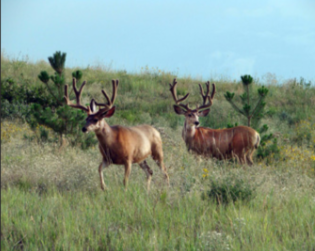
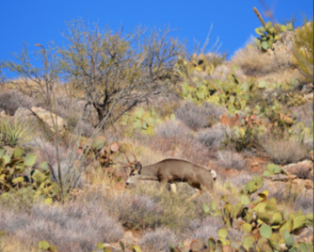
color than their northern relatives, but it is not possible to draw a definitive line between desert and Rocky Mountain mule deer.
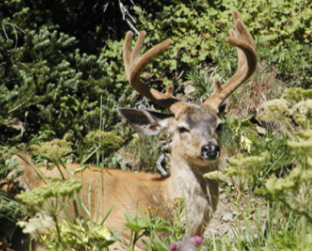
The evaluation of subspecies is more than just looking at some genetic results. Subspecies can differ genetically, physically, or in some important ecological ways. We are accumulating some idea of genetic relatedness among these subspecies, but also have to consider the entire package that may make them different from others of the same species. We are not at the point of making definitive thumbs up or thumbs-down calls on all mule deer subspecies, but there are several clarifications emerging:
- As other researchers have found, blacktails have very different mitochondrial DNA than all other subspecies of mule deer.
- Nuclear DNA relationships indicate mule deer are not ancient hybrids between whitetail mothers and blacktail fathers as sometimes stated.
- Sitka and Columbian black-tailed deer are not genetically very different from each other, despite the physical differences. The Sitka may simply be an island-hopping form of blacktail shaped more by environment than long-term genetic isolation,
- Sitka blacktails have much less genetic diversity than other subspecies, probably because of their history of existing mostly in island populations. The limited gene flow and small population size in island populations can reduce genetic diversity. Also, a few deer colonizing a new island do not carry with them a lot of diversity to start with.’
- The highest area of genetic diversity in blacktails is in coastal Washington and Oregon, indicating this was an ice-free coastal area during the last ice age where black-tailed deer became isolated and developed differently from mule deer.
- The desert mule deer name Odocoileus hemionus crooki is not valid because, as I wrote in a journal article, its scientific designation was based on a specimen that was a mule deer x whitetail hybrid.
- The previously described Inyo Mule Deer (Odocoileus hemionus inyoensis) is not genetically different from other mule deer in California.
- There is no well-defined line that could be drawn between desert and Rocky Mountain mule deer either on a physical or genetic basis; bigger, darker northern deer gradually change to lighter, smaller deer in the Southwest.
- All mule deer subspecies (excluding the two black-tailed deer) are not very different from each other genetically.
- The higher genetic diversity of mule deer in the Southwest indicates that during the greatest extent of glaciation in North America, mule deer were confined to the Southwest and expanded northward as the climate warmed.
- Rocky Mountain mule deer through-out their entire range from northern Arizona and New Mexico up to the Yukon are remarkably similar genetically. This is probably because they expanded northward relatively rapidly at the end of the Pleistocene as the glaciers retreated.
- Tiburon Island mule deer are genetically different from those on the Sonoran mainland even though deer have been known to swim back and forth. Island animals can develop genetic differences that may or may not be related to whether they are different subspecies.
- The mule deer on San Jose Island off the Mexican coast in the Sea of Cortez have never been described in detail, but a few genetic samples from deer there indicate they are no different from the mule deer on the mainland.
We are starting to build a foundation of knowledge about the different “types” of black-tailed and mule deer with recent genetic analysis techniques and a more objective look at the subspecies designations made a century ago. We will continue to refine our knowledge with what we have learned from not only their genetic differences, but also physical and ecological uniqueness that might warrant recognition for conservation reasons. This process of continuing improvement with a science-based approach has always been, and will remain, a critical part of our successful system of conservation.

Jim Heffelfinger is a Certified Wildlife Biologist who has worked as a biologist for the federal government, state wildlife agencies, universities, and in the private sector in Texas, New Mexico, and Arizona. Jim has authored or coauthored more than 200 magazine articles, dozens of scientific papers, and 20 book chapters in regional, national, and international publications. He is Chair of the Mule Deer Working Group, Full Research Scientist at the University of Arizona, Professional Member of the Boone & Crockett Club, and currently works as Wildlife Science Coordinator for the Arizona Game and Fish Department.
If the article above does not loead – please view it here ->
—
